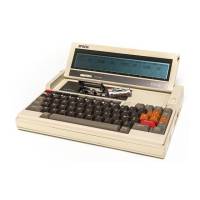4.2 RS-232C interface
The PX-8
is
equipped with
an
RS-232C interface and the operating system sup-
ports a communication speed
of
up to 19200 bps. The RS-232C interface
is
used
to communicate with other computers, to modems acoustic couplers and printers
and other devices which support this communication standard.
The operation mode
of
the RS-232C interface can be specified with the CON-
FIG
program in Chapter 3 or by using the
OPEN
command in BASIC.
The SHIFT-IN/SHIFT-OUT and
XON/XOFF
functions are also supported
by the operating system, but can only be set by BASIC.
The
SHIFT-IN/SHIFT-OUT
protocol allows the full ASCII code from 0 to
255 decimal, but only using seven bits.
It
only operates during seven bit trans-
mission. When a code greater
than
127
is
required, the SHIFT-OUT (SO) code
is
sent to tell the receiving device to set the high bit, i.e. to add
128
to the code
received. Thus
if
the code
65
is
sent when the SO has been sent the receiving
computer will interpret it as code
193
(65
+ 128). The SHIFT-IN code reverses
an
SO condition.
If
a code
193
is
sent
at
when
an
SI code has been sent the
code will be interpreted as code 65. The SIISO codes act as a switch.
For
exam-
ple all characters will have the high bit set until the SI code
is
sent once
an
SO
code has been sent.
When communication occurs with two devices using
XON/XOFF
protocol, the
transmitting device can be told by the receiving device
to
wait until the receiv-
ing device
is
ready to handle further information. This
is
important
if
the receiv-
ing device
is
processing the information and needs time to carry
out
some
operations before receiving more data.
The codes for SIISO,
XON/XOFF
are:-
Decimal Hexadecimal
SO
14
0E
SI
15
0F
XON
17
11
XOFF
19
13
A warm
boot
will set the default setting
of
SIISO
and
XON/XOFF
to off, and
thus to ensure they are
not
active, perform a warm boot before using the CON-
FIG
program to set the parameters.
4-22
NOTE:
The CONFIG program does
not
allow the
XONIXOFF
or
SIISO
protocol to
be
set. This can only be done
from
BASIC,
or
a machine code
BIOS
call.
WARNING:
When sending data which could contain these characters
for
example a
machine code program, the
SHIFT-INISHIFT-OUT
and
XONIXOFF
options should
be
set to
off
If
this is
not
done, when the receiving device
is sent any
of
the above characters it will
be
interpreted as such
and
the
appropriate action will be taken. Consequently the data received will have
the bit setting ch9nged in the case
of
SIISO.
Also
the particular character
being sent as control data
(SIISOIXONIXOFF)
will
not
form
part
of
the data received as it will have been interpreted as a control character.
Before using TERM
or
FLUNK execute a warm
boot
to set the RS-232
parameters
to
the default, and then change them using the CONFIG program
if
necessary. This ensures the SIISO and
XON/XOFF
parameters are set to off.
The RS-232C interface can also be used in BASIC programs. For details
of
use,
refer to the PX-8 BASIC Reference Manual.
The PX-8 uses the RS-232C interface
to
connect a printer unless the system
configuration
is
changed with the CONFIG command.
Examples
of
use
The following command transmits the contents
of
file SAMPLE. TXT to the
RS-232 interface.
PIP
PUN:
= A:SAMPLE.TXT
The following command receives
data
from the RS-232C interface and saves
it
on
the disk in drive A: under the file name SAMPLE2.DAT.
PIP A:SAMPLE2.DAT
= RDR:
The default settings
of
the RS-232C interface operation mode are as follows.
Communication speed:
Character length:
Number
of
stop bits:
4800 bps
8 bits
2
Parity check:
SIISO control:
XON/XOFF
control:
4-23
No
No
No

